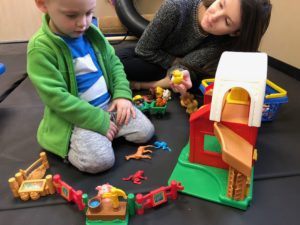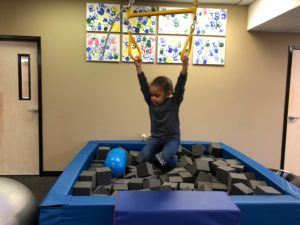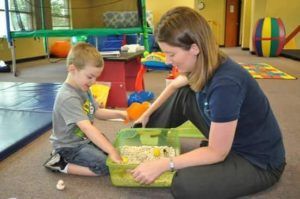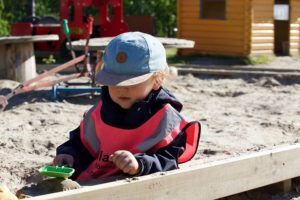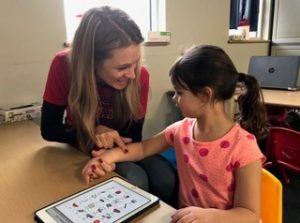child development
ABC Pediatric Therapy Network is always about progress! If you are receiving services somewhere other than ABC Pediatric Therapy Network and your child is achieving success, DO NOT change a thing. That is what ABC is all about …. SUCCESS! We want your child to be consistently showing progress. We, like you, want your child to reach their maximum potential.
View this post on Instagram
Testimonial Tuesday! Tell us something great about your child’s therapist!

If your child is not achieving success….at school, home therapy, outpatient therapy…. ask more questions. Ask what the goals are and why your child is not achieving them. Maybe modify the goals or the strategies to achieve them. Is your team on board to create change that is responsive to your child’s needs?! Let’s hope so!
Perhaps now is time for a change.
If you are receiving therapy at school, call an IEP meeting to discuss strategies. You might be able to increase the minutes your child is seen. Maybe you just need to modify the approach to the goal. You could change the location where the goal is being worked on – if in the classroom, try a private room. Maybe your child is being seen in a group and one on one would be better. Perhaps the stairs in the school are not motivating but the stairs to the playground are.
Add additional outpatient therapy to increase the intensity to reach goals. Having another perspective from another therapist can be beneficial. Private therapy is usually individual and this increased intensity might be just what your child needs.
Is summer approaching? What is your plan to push potential during the summer?
Are you at an outpatient facility and your child needs a change? Each outpatient therapy office has a different approach to treatment. Take a tour at another facility to see what best meets your child’s needs.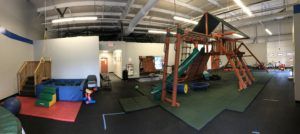
Therapy…success…change…progress – is all about communication. Your therapy team needs to listen to your and your child’s wants/ needs and modify the plan of care constantly to be responsive to you and your child. If you have found that…great! Celebrate the small victories and push for the big wins! If you have not found that, do not stop advocating for your child. You are often their voice as well as their cheerleader!
*Find the therapy approach – outpatient, school, one on one or group – that succeeds in ensuring your child progresses.
*Increase communication – update or change goals to accomplish more developmental milestones.
*Increase frequency – attend therapy more often or add outpatient to school therapy.
Whatever you do, do not stop trying something new or something different than what you are doing now until you see the progress you want for your child.
You know your child best. Achieving developmental milestones increases self esteem in your child. Feeling like you can do the same tasks as your friends creates a sense of acceptance and achievement.
Empower and educate yourself at www.abcpediatrictherapy.com. Reach out to ABC if we can help you in any way!
Read MoreThe ABC Interactive Screening Tool was developed to empower the parent. We want parents to know what to challenge and when. We do not want your child arriving at preschool or kindergarten not being able to cut, put on their coat or eat the snack provided. What can you, as a parent, do to ensure your child is reaching their potential? The answer…. get educated. We want to help! First, click below to fill out the online screening tool.
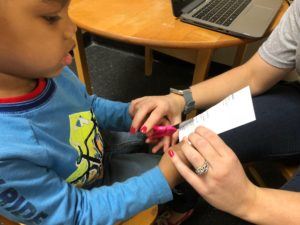
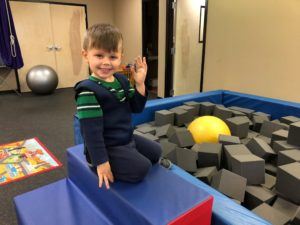
Ok, you have filled out the tool. Now what?!?
The tool was designed to be a quick look at how your child is doing. A chance for you to take a look for yourself. Try age appropriate skills with your child to really see for yourself how they are doing.
It is important to understand that this was just a glimpse. A full evaluation of skills at each age level would look at 50 or more skills where this tool only looks at 7- 10 skills for gross motor, fine motor and speech/language skills.
If your child misses 2 or more skills in any one area, we recommend an evaluation of those skills by a licensed therapist. Why? A therapist will be able to teach you what to encourage at home and how. Therapy may or may not be recommended for your child. A therapist wants to ensure that each child reaches age appropriate milestones in a timely manner.
If your child misses 2 or more skills when we are assessing 7-10 skills in the Interactive Screening Tool, we expect that they might miss significantly more when assessing 50 skills in a formal evaluation!
What could happen if my child is behind on skills?
Compensatory patterns could develop if your child is not achieving milestones. Your child may try to figure out how to achieve a skill even though muscle weakness exists. This may lead to the development of bad patterns that will affect future skills. For example, speed and agility for sports may be affected if a child does not develop higher level balance skills like 1 foot standing or walking on a balance beam. A child that does not spend time on his belly may show signs of weakness in his trunk or arms effecting handwriting or scissor cutting later. Children that do not like to climb on jungle gyms or swing on swings might find that riding a 2-wheeler is challenging in the future. This could affect social skills and friends as their friends will take off on their 2 wheeled bikes leaving your child behind to find a more sedentary activity to play.
Why does it matter if my child achieves skills on time?
As a parent, we want our children to succeed at their fullest potential. If our child like Legos or playing the trombone or playing football, all are great. We do not want them to be limited by their motor skills in their choices of what they choose to do or who their friends are. We want them to be able to decide based on their interests not their lack of ability.
For example, if your child chooses not to play sports. That is fine. As a parent, we just do not want him/her not to choose sports due to poor balance or strength.
If your child chooses not to be an artist, we do not want that choice influenced by weak hand/arm muscles. But just that your child prefers something else.
Our job as a parent is to challenge our child at their fullest potential and encourage them to make choices based on their interests.
So get educated. Know what your child needs to know how to do and when. That way you will have the right toys in your house. You will know when to get out the messy glue and paint. You will know when to supervise the scissor cutting. You will know when to leave extra time to “make“ your child tie his/her own shoes or even to be sure they are wearing tie shoes.
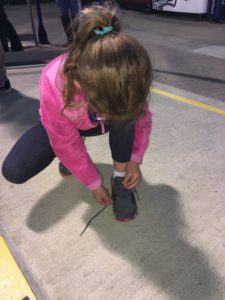
Good job parent! You are now educated on what your child should do and when.
Now, pay it forward!
Who else in your world wants to be an informed parent that can empower their child to reach their fullest potential!?! Share this link with them [email protected]!
Let’s change the lives of children together!
You will find answers to many of your developmental questions at https://www.abcpediatrictherapy.com
Read MoreWhat is it?
A tool to help parents know what their child should be doing and when. 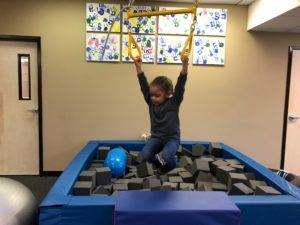
How does it work?
It is simple. Simply plug in your child’s birthdate. The gross motor, fine motor, language and sensory tasks that your child should do at that age will pop up. Answer the questions indicating what your child can and cannot do.
After submitting the tool, you will receive an email with tips and tricks on how to help your child at home. You also receive a FREE developmental checklist of all the skills a child should do between the ages of 1 and 6 years old.
Practice these age appropriate skills with your child. We hope you have success challenging them!
Let us know if we can help you.
Why did ABC Pediatric Therapy develop this tool?
ABC found that many parents do not know what to encourage and when. We want to help! This tool will teach you what toys to have and what skills to challenge at what age. Educate yourself! Be the best parent you can be! Challenge your child’s skills!
Who would find this tool useful?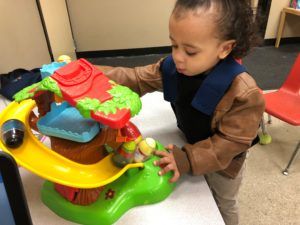
Any parent of a child under the age of 6 years old.
You can find this Interactive Screening Tool at checklist.abcpediatrictherapy.com. We hope you find it useful!
Visit our website at https://www.abcpediatrictherapy.com for more information on child development.
Read MoreBy the time a toddler has a vocabulary of at least 30-40 words, they begin to put words together into 2-word phrases (the child must be USING the 30-40 words in spontaneous speech to comment/request/label, not just imitating). The general “rule of thumb” is that at age one, children use only ONE word to communicate, then at age two, they use TWO words, by age three, they are using THREE or more words in sentences (requesting/commenting/asking & answering questions). I find myself using the following strategies right now with my 24-month-old and thought I’d share some ways to help increase the 2-word phrases in your toddler’s vocabulary.
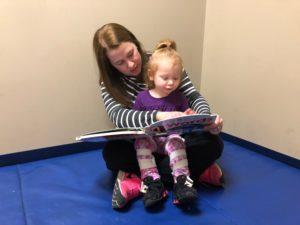
- One simple way is to build phrases using words your child already has in their vocab.: Does your child have some functional words associated with mealtime, bedtime, playtime etc.??? Try adding MORE and PLEASE to those words. For example, “more juice”, “help please”, “out please”. “more crackers”, “up please”.
- Incorporate greetings to build phrases: “Hi daddy”. “bye-bye nana”

- Model phrases throughout your daily routines, commenting on what is happening or what your child is doing, “night-night baby”, “go out”, “want up?”, “purple ball”, the more these phrases are modeled, the greater the chance your child will begin to imitate!
- Incorporate “automatic” phrases as well: For example, “I did it”, “this one”, “that one”, “my turn”, “let’s go”, “no mine”
- If you notice that your child isn’t quite catching on to 2-word phrase imitation, begin by repeating single words in a string, for example, “go-go-go!”, “up-up-up”, “night-night” to see how they respond.
If you have concerns about your child’s development, visit our webpage at https://www.abcpediatrictherapy.com for more information.
Written by: Christina Sanford, MA, CCC-SLP
Read More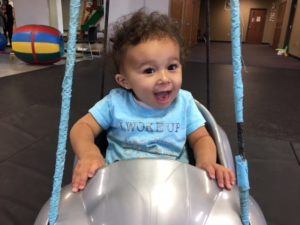
| By 6 Months | · Does not laugh or squeal · Does not look toward new sounds · No eye contact with parent |
| By 9 Months | · Has limited or no babbling |
| By 12 Months | · Does not point to objects · Does not use gestures such as waving |
| By 15 Months | · Does not have “first” word · Does not respond to own name |
| By 18 Months
| · Does not use at least 6-10 words consistently · No imitative skills (gestures or verbal) |
| By 20 Months | · Does not follow simple directions |
| By 24 Months | · Has a vocabulary of less than 50 words · Has decreased social interactions · Not combining words |
| By 36 Months | · Strangers have difficulty understanding what the child is saying · Short utterances only; limited conversational skills |

If you have questions about your child’s development, visit our website at https://www.abcpediatrictherapy.com
Written by: Christina Sanford, MA, CCC-SLP
Read MoreComing up to the holiday season, many parents have questions about the best toys for their toddlers. Our day to day routines have evolved to promote children spending time in “containers.” This can be sitting in a car seat, jumpers, activity chairs, long periods in high chairs, etc. While convenient and necessary, it is also important to encourage your child to have plenty of breaks from these devices and get them moving around and playing with toys that stimulate different body systems. This holiday season, consider some of the following ideas to help promote your toddler’s development:
- Wooden blocks/mega blocks
- Connecting toys such as pop beads
- Stacking peg board

- Stacking rings
- Activity tables to promote standing and cruising
- Bubbles

- Make your own sensory bins; fill different containers with beans, rice, cereal, water beads, etc and hide holiday objects to find inside
- You can make your own Candy Cane cloud dough for a themed option. Recipe here: http://www.growingajeweledrose.com/2012/12/candy-cane-clouds-sensory-activity.html
- Playground ball, soccer ball, basketball, etc.
- Art station
- You can set up a station to play with puff paint or shaving cream and “draw” with fingers; this idea works great on a mirror or flat, easy to clean table surface
- Non-toxic art supplies
- Palm grip crayons
- Large chalk

- you can make your own chalkboard table by painting an existing small table with chalkboard paint
- Easel
- Sand box with pail and shovel
- Dress up box
- Board books
- Simple jigsaw puzzles
- Musical instruments – you can look for toy versions that pair light and sound when playing the instrument
Remember not all games/toys have to be costly or expensive! Time and time again, parents say their children love playing with household items. Get creative by putting a holiday spin on toys and games your children love. Feel free to share your ideas with other parents on our facebook page….
If you have questions about your child’s development, please call us at 513-755-6600 or visit our website at https://www.abcpediatrictherapy.com
Read MoreDid you know by 3 your child’s diet should typically consist of a variety foods with various textures, sights, temperatures, colors and consistencies? If your child is not eating a variety of fruits, vegetables, meats, and mixed foods (such as mac and cheese or spaghetti), then your child may be a picky eater.
Before addressing feeding, make sure you child’s sensory needs are being meet. Sometimes addressing sensory concerns, such as deficits in proprioceptive input (knowing where your body is in space through heavy work or deep pressure), vestibular input (movements such as swinging), and or tactile input (how your body reacts to touch) can be enough input to help your child try new foods.
Having your child jump on the trampoline or in place, wheelbarrow walk or any animal walk to the dinner table, and or swing prior to eating could be good activities to complete before meal time. Your child could also benefit from the brushing protocol to help with sensory input (contact an occupational therapist at ABC Pediatric Therapy for more information on this protocol). Also, make sure child is okay with getting messy. If s/he is not, it will be beneficial to address this first as well.
Using shaving cream is one of the easiest messy play activities. At first, make sure your child tolerates being in the same area as the shaving room. Once s/he tolerates being near the shaving cream, have your child begin interacting with it. Put cars, planes, or boats in it and have the child push these around without touching the shaving cream. Slowly begin introducing shaving cream onto the cars and see if your child will continue to touch the cars. Once they do, see if your child will imitate you drawing roads for these cars in the shaving cream. After your child tolerates interacting appropriately with the shaving cream your child is ready to begin trying new foods.
Dr. Kay Toomey developed a feeding hierarchy that has been proven to have great success is regards to sensory picky eaters. Following along the same lines as shaving cream play, Dr. Toomey wants children to be able to tolerate and interact with new foods before actually eating them. If they are not able to tolerate being at the table with the food, then they are not going to be able to interact with it.
To assist with interacting with food, have your child prepare food and use utensils or the container to stir or pour foods/drinks. If your child is having difficulty with using utensils and self-feeding skills, please contact an occupational therapist for additional assistance.
Once your child interacts with foods, the next step on the hierarchy is to smell the foods; have your child lean down or pick it up to smell the food. The next big step is touching foods; go from touching it to his/her fingers to whole hand to chin/nose to lips to teeth to tip of tongue to full tongue to licking it. At this point, reward your child with a preferred food after 1-3 consecutive touches or licks of a non-preferred food. After your child is licking new foods, the next step is to begin tasting them. Initially have him/her take a small bite and designate a spit out jar. Once s/he is able to do this, see if your child can hold the food in his/her mouth for a certain amount of time or even chewing a certain amount of times before spitting out. The next goal would be to chew and swallow with a drink and then independently. Also, at this point, begin rewarding your child with a preferred food after so many bites of a non-preferred food. For example, have your child take 2 small bites of a green bean before being rewarded a preferred gold fish and then repeat this until you are satisfied with how many bites of a non preferred food your child is eating in one sitting.
If your child is not making the progress you want, your child may have oral motor deficits. For example, if your child is only eating softer, blander foods, they may have decreased strength. They may also have an immature chew which could make feeding difficult. An occupational therapist would also be able to assess this. A therapist will also be able to determine if your child is having sensitivities to the temperature, texture, flavor, sight, or smell of certain foods which could be inhibiting his/her success.
Please contact ABC Pediatric Therapy for more ideas geared towards your specific needs and if you have any additional questions. Visit our website at www.abcpediatrictherapy.com to find the location nearest you.
Read MoreIn order to learn about the world around them, children need to experience a variety of environments and situations. They need to be able to move, explore, climb, play, learn, and rest. In order to do all of these things as efficiently as possible, children need a varied diet full of nutrients. Without these critical nutrients, children may not have the energy, attention, or cognitive functioning to absorb all of the information around them.
Eating balanced and nutritious meals is crucial for a child’s overall health and development. As we grow, our bodies use the nutrients we get from food to help us function and perform daily tasks. According to the article “The Importance of Healthy Eating in Children” posted on www.livestrong.com, children need “plenty of water and enough protein for growth and cellular repair. Children need adequate carbohydrates for their high energy levels and just enough fat to provide essential fatty acids for cell growth. Finally, children’s diets require enough iron, calcium and vitamin D to strengthen blood and bones as well as zinc and magnesium to support the immune system. All of these nutritional requirements can be met through a diet high in fruits, vegetables, grains and meats.”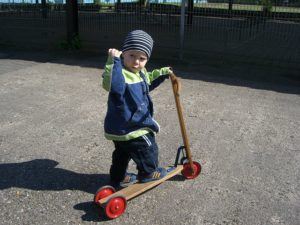
If you are having trouble getting your child to eat a variety of foods, here are some tips and strategies to try at home:
• Try new foods that are similar to those your child already enjoys. For example, if your child likes French fries, try introducing a few sweet potato fries on their plate. If your child likes pizza, try adding chopped up vegetables on the pizza. If your child likes chips, try pretzels or veggie straws.
• Use what your child likes to your advantage. If your child likes cheese, try broccoli and cheddar soup or cooked vegetables with cheese sauce. If your child likes macaroni and cheese, try using vegetable pasta instead of regular pasta.
• Involve your children in the food-making process. Take them grocery shopping, have them help mix ingredients together, or have them taste-test along the way. Knowing that they were part of making the food may encourage kids to try the finished product.
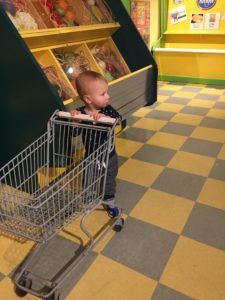 • Consider planting fruits and vegetables outside. This can be a great learning experience for children on where food comes from, as well as an opportunity to try something they actually grew.
• Consider planting fruits and vegetables outside. This can be a great learning experience for children on where food comes from, as well as an opportunity to try something they actually grew.
• Take advantage of dips. Find a dip that your child enjoys, such as ranch, spinach and artichoke dip, or hummus. Use that as a tool to encourage trying new foods to dip.
• Make mealtimes and food prep fun and be creative. Use cookie cutters to cut food into different shapes, make silly meals from your children’s favorite TV shows, or come up with silly names for foods.
• Give your child choices. Children like to be in control and letting them pick from a few choices of what they will have on their plates is a good way to increase cooperation.
• Limit grazing. This will help your child establish an internal system that promotes eating when they are hungry rather than snacking throughout the day, which can increase their willingness to try new foods.
• Find foods that are your child’s favorite color, or try to eat all the colors of the rainbow. Make a game out of it and see who can eat the whole rainbow first
For more information on typical oral motor and feeding development in children, visit www.abcpediatrictherapy.com and review the developmental checklists. For guidelines regarding suggested dietary needs for children of different ages, review https://www.mayoclinic.org/healthy-lifestyle/childrens-health/in-depth/nutrition-for-kids/art-20049335. If you have additional concerns about your child’s diet and nutrition, speak to your pediatrician.
Try the above tips and if your child does not begin eating a variety of foods, reach out to us! We, at ABC Pediatric Therapy Network, can help!
Read MoreMealtimes and food are such an important part of our society and culture. We eat together as families, we go out to restaurants with friends, and we bring appetizers and snacks to gatherings for all to enjoy. A significant amount of our social lives and family routines revolves in part around food. For families with children who are picky eaters, these enjoyable and social experiences can become stressful and conflict-causing situations.
Picky eating can lead to serious health concerns and have long-term effects on the well-being of the child. Picky eaters often have a very limited diet – eating only a handful of foods willingly. Because of this, picky eaters are not typically getting all their nutritional needs each day. This can lead to deficiencies, such as iron, calcium, zinc, and vitamin deficiencies for example, which can lead to other illnesses and complications later in life. These deficiencies can also have the following negative effects:
· decrease your child’s attention and energy levels, which can prevent them from being able to explore their environment and learn new information as efficiently
· decrease cognitive functioning
· weaken their immune system, making it harder to fight off illnesses and diseases
· increased risk for weight problems (under or overweight)
· dental problems if preferred foods are limited to snack items/sweets
Not only does picky eating affect a child’s health and well-being, it also negatively impacts the social well-being of the child and the family as a whole. As a parent, one of your primary roles is to provide for your child, and not being able to fulfill that role can be stressful, isolating, and extremely frustrating. Increased stress can lead to conflict in relationships, including the parent-child relationship, as well as the relationship of the parents. Picky eating can lead to refusal of foods and negative behaviors from the child (screaming, crying, etc.). These behaviors can all increase a parent’s stress and frustration, as well as lead to negative feelings and attitudes towards mealtimes and family routines. For the child, not being able to participate in snack or mealtimes at school or daycare can negatively impact his/her ability to interact with peers and learn social norms.
For more information on typical oral motor and feeding development in children, visit abcpediatrictherapy.com and review the developmental checklists. If you have concerns regarding picky eating, here are a few tips to try at home:
· Create a mealtime routine and try your best to stick to it. Children thrive with routines. Having a routine helps them understand what is happening right now and what to expect next. This can help lessen anxiety, especially when introducing and trying unfamiliar foods (which can be an anxiety-causing situation for many children). Try to eat meals around the same time each day and in the same place, such as at the table.
· Give your child choices. Children like to be in control and letting them pick from a few choices of what they will have on their plates is a good way to increase cooperation.
· Limit grazing. This will help your child establish an internal system that promotes eating when they are hungry rather than snacking throughout the day.
· When introducing new foods on the child’s plate, always offer foods that the child likes and will eat, as well.
· Try to boost the nutritional value of the foods in the child’s current diet. For example, if the child likes smoothies, mix in some yogurt for added protein or some spinach for added vitamins and minerals. Consider vitamins and other supplements, as well.
· Provide lots of positive feedback, even for small victories. If a child allows an undesired food to stay on his/her plate the whole meal instead of throwing it on the floor, tell the child how proud of them you are. Use sticker charts, rewards and incentives, etc. to increase cooperation.
If you try these suggestions and are still struggling with success at mealtimes, please reach out to us at ABC Pediatric Therapy Network. We can help! Family time should be full of wonderful memories and not stressful power struggles.,
Read MoreAnswering and asking questions is an important part of learning. We ask questions in order to learn more information about something, and we answer questions to provide more information. Asking and answering questions is not only a part of how we learn, but it is also a part of our social skills; we ask and answer questions to be polite and build and maintain relationships. Types of questions we ask and answer include “who”, “what”, “where”, “when”, and “why”.
Answering questions involves having a child hear the question, think about the meaning of the question, understand the meaning of the question, form an answer, and speak the answer that they formed. Asking questions involves thinking about what you want ask, forming the question in your mind, and then producing the question that you want to ask. For children with speech and language delays, asking and answering questions can be a challenge. This challenge in asking and answering questions may affect their ability to learn and their ability to develop and build relationships.
Believe it or not some questions are easier to ask/answer than others. “What” questions are the easiest to learn, followed by “Who”, then “Where”, followed by “When”, and finally “Why”; “Why” questions being the most difficult for children to learn and master.
The following is a basic guideline on the types of questions a child may ask/answer according to their age. More information can be found at: https://parentresourcesblog.files.wordpress.com/2013/05/questions-development.pdf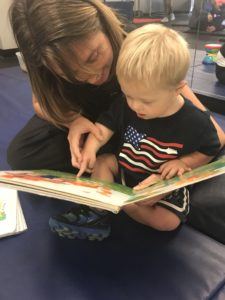
· Between 12-24 months, a child should be able to answer basic “What’s this?” questions about familiar objects, answer basic “where” questions by pointing, answer basic yes/no question by shaking their head or nodding, and use a rising pitch in their voice to indicate that they are asking a question (e.g., Daddy? to ask “Where is daddy?”)
· Between 24-36 months, a child should point to objects being described (e.g., “Where do you wear a hat” and the child points to their head), answer longer “Where”, “What…doing”, and “Who is” questions, understand “Can you” questions, ask questions to get their basic wants/needs met (e.g., “where cup?”), and ask one-word “why?” questions
· Between 36-48 months, a child should answer more complex questions, answer questions about object functions (e.g., what do you do with a spoon), and answer “if…what” questions (e.g., if you get sick, what would you do?)
If you find that your child is having difficulty asking/answering questions determine the type of question(s) that is the most problematic. Once you have figured out the type of question that is challenging for your child, talk about what it means to ask/answer that type of question. For example,
· “what” means we are talking about a thing, such as the dog, the house, a cracker, etc.
· “who” means we are talking about a person, like mommy and daddy, grandma/grandpa, etc.
· “where” means we are talking about a place or location, such as the park, our house, or in the kitchen.
· “when” means a time, such as daytime/nighttime, breakfast, summer, yesterday, or even a month like December
· “why” means a reason, such as I fell down because I tripped on a rock.
Once you have talked about the type of question that is troublesome, use games and activities involving questions to teach your child about asking/answering questions while having fun at the same time. Games and activities could include, but are not limited to: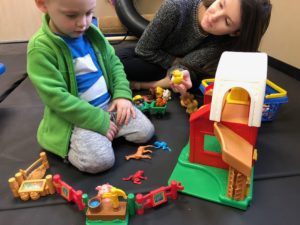
· “Wh” Bingo
· I Spy
· Asking questions while reading a book
· Asking questions while playing with toys (e.g., Where is the cow? What animal is this?)
· Headbanz Game
If your child is still struggling to ask/answer questions or other speech and language skills, it is recommended to seek out a Speech and Language evaluation from your local Speech Therapist to determine if your child would qualify from services to improve these skills. For more information visit https://www.abcpediatrictherapy.com
Read More Skip to content
Skip to content
